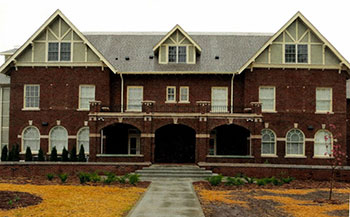
Martinsville Sanitarium, Martinsville, Morgan County
Eligibility Requirements
In order to be eligible for the Federal Historic Tax Credit, the following must be met:
1. Building must be listed in the National Register of Historic Places (National Register), either individually or as a contributing property to a historic district. The easiest way to verify that a building is listed in the National Register is to check the Indiana Historic Buildings, Bridges, and Cemeteries (IHBBC) Map.
2. Property must be income-producing for at least five years after rehabilitation. This may include, but is not limited to, proposed uses such as a hotel, restaurant or bar, retail, office, residential rental property, industrial, or agricultural property. Owner-occupied residential properties do not qualify for this program but may be eligible for the Residential Historic Rehabilitation Tax Credit.
3. The project must meet the "substantial rehabilitation test”. The cost of a project must exceed the greater of $5,000 or the building’s adjusted basis. The National Park Service provides the following formula to calculate the adjusted basis:
A - B - C + D = adjusted basis
A = purchase price of the property (building and land)
B = the cost of the land at the time of purchase
C = depreciation taken for an income-producing property
D = cost of any capital improvements made since purchase
Not every expense associated with a rehabilitation project contributes toward the calculations for the credit. In general, only those costs that are directly related to the repair or improvement of structural and architectural features of the historic building will qualify. See the IRS guidance on Qualified Rehabilitation Expenses.
4. The rehabilitation work must be done according to the Secretary of the Interior’s Standards for Rehabilitation (Standards). After the project is complete, all subsequent work within a 5-year period must comply with the Standards and be approved via an amendment by the National Park Service. Not complying with the Standards puts the applicant at risk of having their credits recaptured.
Additional information can be found on the Eligibility Requirements page of the National Park Service website.
Rehabilitation Tax Credit Projects in Indiana and the National Register of Historic Places
Guidance for Tax Credit Projects when the building is not yet listed in the National Register of Historic Places
It is possible to pursue tax credits for properties that are determined to be eligible for listing in the National Register of Historic Places but are not yet listed. In these cases, the tax credit review and National Register review and listing processes can be completed concurrently, following the steps below:
- Determination of Eligibility - Submit the Determination of Eligibility form to the Survey and Register staff at DHPA. All relevant sections of the form, including the submission of current exterior and interior photographs and maps/floor plans, must be completed. The DHPA staff reviews these requests once a month.
- Part 1 – Part 1 of the Federal Historic Tax Credit can be submitted to DHPA either at the same time as the Determination of Eligibility request or after the applicant is informed of the DHPA decision on the eligibility. Once Part 1 is reviewed by the Tax Credit Reviewer at DHPA and determined to be complete, it will be forwarded to the National Park Service (NPS) for approval. Please note that DHPA and NPS each have 30 days to review applications from the date they are received.
- National Register nomination - Once the Part 1 application is approved by NPS, the applicant should prepare and submit the National Register of Historic Places nomination form to DHPA as soon as possible. The nomination form will go through technical and substantive review phases, as all National Register forms do in Indiana. This process can continue as the tax credit parts move forward. For questions regarding the timing on the remainder of the tax credit process please contact DHPAtaxcredits@dnr.IN.gov.
- Once the nomination reaches substantive review (may take between 12 and 18 months from the date the nomination passed technical review), DHPA staff will contact the applicant to determine how far the rehabilitation project has progressed.
- If the rehabilitation project has been completed to a point where an updated description and photos that reflect the building(s) in rehabilitated or near-rehabilitated appearance and condition can be provided, then that information must be provided before the nomination is presented to the Indiana Historic Preservation Review Board.
- If the rehabilitation project is not at that point, then the applicant is required to submit the updated information and photographs as additional documentation for the National Register file as soon as possible (submitted to our office before or at the same time as the Part 3 for tax credits). This may be after the property has been listed in the National Register by NPS.
- Once the nomination reaches substantive review (may take between 12 and 18 months from the date the nomination passed technical review), DHPA staff will contact the applicant to determine how far the rehabilitation project has progressed.
- Indiana Historic Preservation Review Board - Once the nomination is determined to be complete, it will be scheduled for consideration by the Indiana Historic Preservation Review Board. Upon approval by the review board, DHPA will forward the nomination to NPS for listing.
